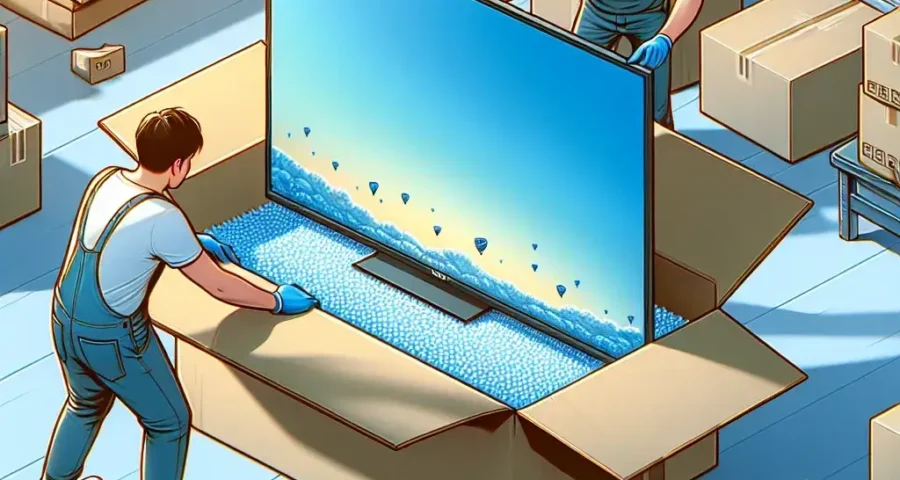Introduction
Transporting an LED monitor can be a daunting task, especially if it’s a high-end model with a large screen size. Whether you’re moving to a new house, traveling for work, or sending it to a service center for repairs, knowing the best practices for transporting your monitor can save you from potential damages and ensure its longevity.
Why Proper Transportation is Crucial
LED monitors, like all electronic devices, are delicate and susceptible to damage from physical impact, vibrations, and environmental factors such as moisture and extreme temperatures. Properly transporting your LED monitor is crucial to avoid:
- Screen damage: Scratches, cracks, and dead pixels can occur if not handled carefully.
- Internal component failure: Circuit boards and internal wiring can be damaged by jolts and drops.
- Warranty voiding: Improper handling can void your manufacturer’s warranty.
Preparation Steps
Before you start the transportation process, it’s crucial to prepare your monitor adequately. Here are the key steps:
- Backup Data: If your monitor has built-in storage or settings that can be exported, ensure you back up everything.
- Turn Off and Disconnect: Power down the monitor and disconnect all cables (power, HDMI, VGA, etc.).
- Clean the Monitor: Dust and other particulates can scratch the screen during transport, so clean it with a microfiber cloth.
- Original Packaging: The best way to transport your LED monitor is using its original packaging. This packaging is designed to fit your monitor perfectly, providing cushioning and protection.
- Alternative Packaging: If the original packaging is not available, use a sturdy box slightly larger than the monitor, packing materials (bubble wrap, foam padding), and anti-static bags.
Comparison of Original vs. Alternative Packaging
| Aspect | Original Packaging | Alternative Packaging |
|---|---|---|
| Fit | Perfect | Varies |
| Cushioning | Optimized | Can be achieved |
| Availability | Depends on buying decisions | Always accessible |
Packaging the Monitor
Using Original Packaging
- Remove the Stand: Most LED monitors allow the stand to be detached. This makes the monitor less bulky and easier to pack.
- Secure with Foam: Place the monitor in its original foam padding. Ensure the screen side is facing the foam to prevent scratches.
- Box It Up: Place the foam-protected monitor in the original box. Ensure the box is securely taped.
Using Alternative Packaging
- Select a Box: Find a sturdy box that is slightly larger than the monitor.
- Protect the Screen: Use a layer of bubble wrap or foam wrap around the screen.
- Wrap the Entire Monitor: Use bubble wrap or foam padding to wrap the entire monitor, ensuring all sides are protected.
- Secure in the Box: Place the wrapped monitor in the box. Fill any empty spaces with packing peanuts or additional bubble wrap to restrict movement.
- Tape and Label: Seal the box securely with strong packing tape. Label it ‘Fragile’ and ‘This Side Up’ to guide the handlers.
Transportation Methods
Based on the distance and mode of transport, you can choose among the following methods:
By Car
- Back Seat or Trunk: Place the boxed monitor upright on the back seat or trunk. Use seat belts or straps to hold it in place.
- Avoid Stacking: Do not place heavy items on top of the monitor box.
- Drive Carefully: Avoid rough roads and drive smoothly to reduce jolts and bumps.
By Air
- Carry-On vs. Check-In: If regulations allow, consider bringing the monitor as a carry-on to personally ensure its safety.
- Use Fragile Services: Some airlines offer special handling services for fragile items.
- Pack Well: Ensure the monitor is packed securely and labeled as fragile.
By Courier Service
- Choose a Reliable Courier: Use renowned courier services known for handling fragile items.
- Insure the Package: Opt for insurance to cover potential damages during transit.
- Track the Shipment: Use tracking services to monitor your package.
Upon Arrival
Once the monitor reaches its destination, follow these steps:
- Inspect the Packaging: Check for any visible damages to the packaging before opening. Document with photos if needed.
- Unpack Carefully: Remove the monitor from the box carefully, avoiding any sharp tools that could damage the screen.
- Reassemble and Test: Attach the stand and cables, power on the monitor to test if it works correctly. Look for any physical or performance abnormalities.
- Report Issues: If you find any problems, report them to the courier or airline immediately.
Conclusion
Transporting an LED monitor can be stress-free if you follow the right steps and use appropriate packaging materials. Whether you’re moving it by car, air, or courier service, the key is to minimize physical shocks and environmental exposure. Always remember, proper preparation and careful handling go a long way in ensuring your monitor’s safety.


Leave a Reply